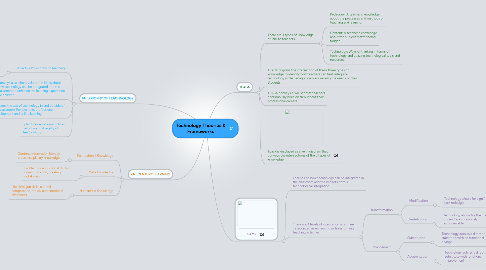
1. 21st CENTURY LEARNING
1.1. Foundational Knowledge
1.1.1. Content, information literacy, cross disciplinary knowledge
1.2. Meta Knowledge
1.2.1. Problem solving, critical thinking, communication, creating, collaborating
1.3. Humanistic Knowledge
1.3.1. Life skills, job skills, cultural competence, ethical and emotional awareness
2. PHILOSOPHY OF TEACHNOLOGY
2.1. Reflects a Philosophy of Teaching
2.1.1. Teachers may develop written statements that describe their Philosophy of Teachnology
2.2. Conveys a teacher's values and ideas about how technology can be integrated into the classroom to enhance the learning experience for children
2.3. Includes the use of technology in and outside of the classroom. For example: professional development and online learning
2.4. I plan to integrate my PLN as part of my Philosophy of Teachnology
3. TPACK
3.1. There are 3 types of knowledge crucial to teachers
3.1.1. Pedagogy: A teacher's knowledge about the processes and methods of teaching and learning.
3.1.2. Content: A teacher's knowledge about the subject matter being taught.
3.1.3. Technology: Ways of thinking in terms of technology and utilizing technological tools and resources.
3.2. TPACK displays the intersection of these three types of knowledge to identify how teachers can best integrate technology while pedagogically addressing the needs of their students.
3.3. TPACK conveys a skill set that teachers continuously build on throughout their professional careers.
3.4. Tpack is displayed as a venn diagram that conveys the intersections of the 3 types of knowledge.
4. SAMR
4.1. Focuses on how technology can be integrated in the classroom and the impacts of this technological integration
4.2. There are 4 levels of integration which are categorized as enhancing or transforming teaching activities
4.2.1. Transformation
4.2.1.1. Modification
4.2.1.1.1. Technology allows for significant task redesign
4.2.1.2. Redefinition
4.2.1.2.1. Technology allows for the creation of new tasks previously inconceivable
4.2.2. Enhancement
4.2.2.1. Substitution
4.2.2.1.1. Technology acts as a direct tool substitute with no functional change
4.2.2.2. Augmentation
4.2.2.2.1. Technology acts as a direct tool substitute with functional improvement
